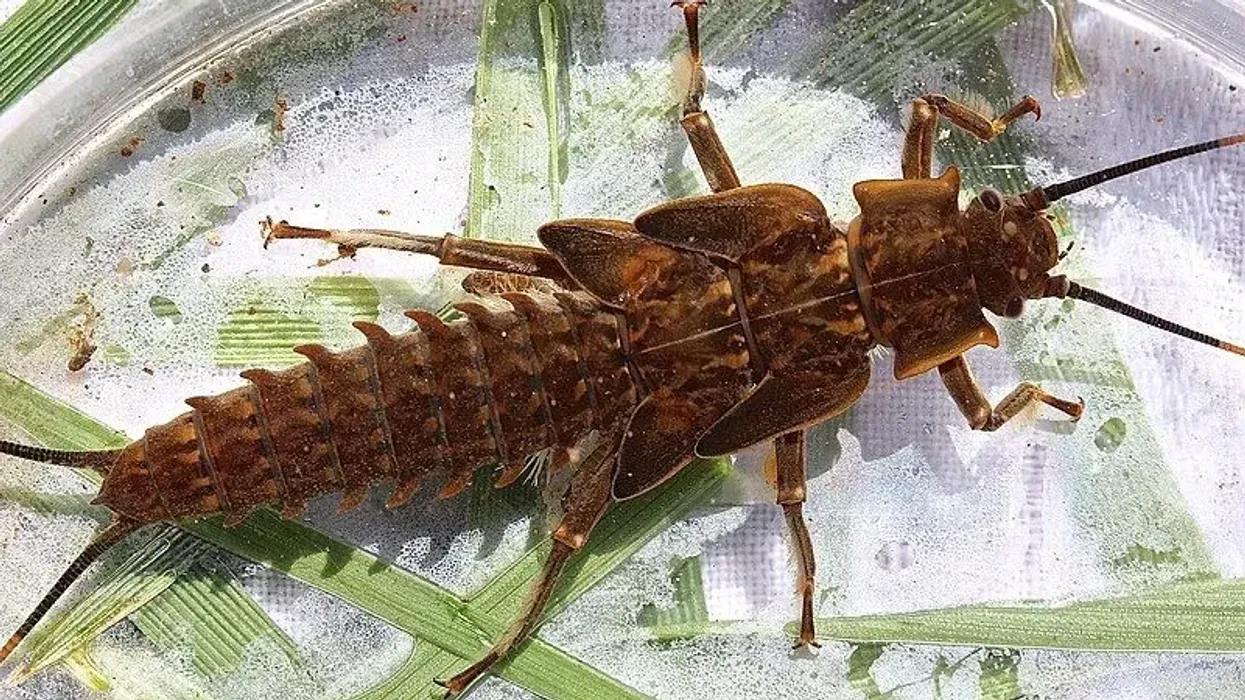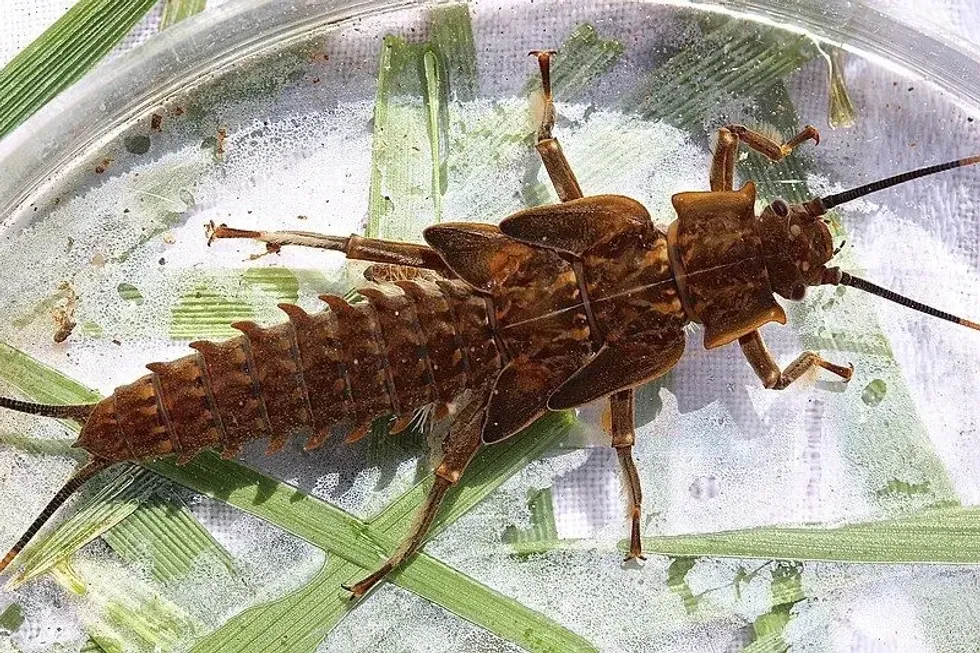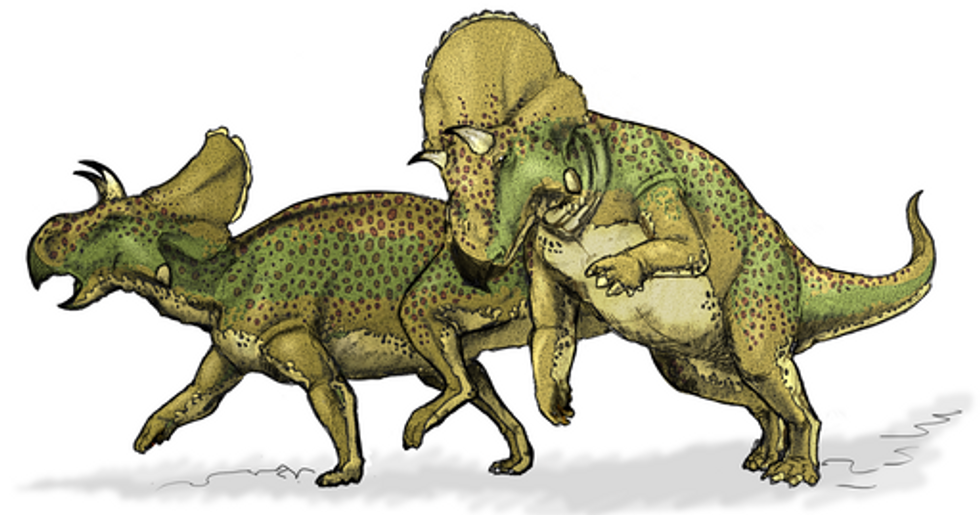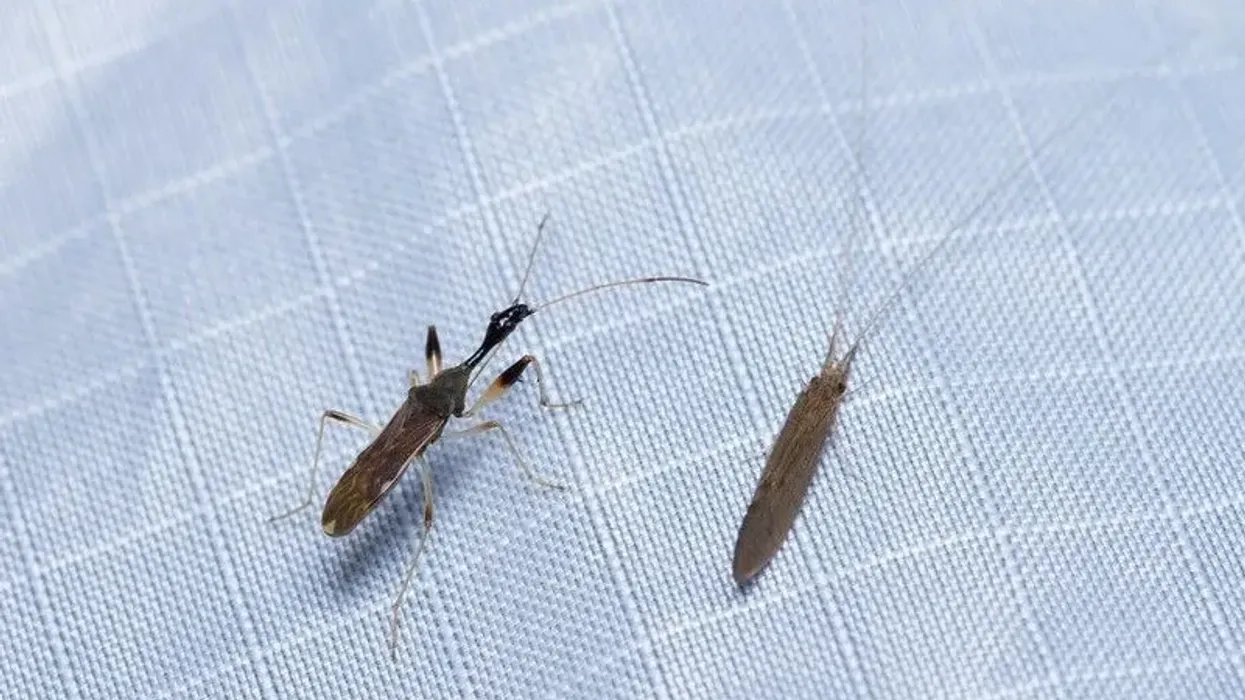The giant stonefly, commonly known as the giant salmonfly, belongs to the family Pteronarcyidae and the order Plecoptera. They are also known as 'shredders' as when they feed, they break down detritus from big bits to small ones.
The adult giant stonefly is quite big when compared to other insects and it has orange-colored leg joints, thorax, and abdomen. Their length ranges between 1.57-3.3 in (40-84 mm) giving them the name 'giant stonefly'.
They have two pairs of wings that have a longer length as compared to the body and remain flat over the body when this insect is at rest.
This stonefly can be spotted around fast-moving streams in the mountains and rivers of North America, ranging from British Columbia to California. Young giant stoneflies spend their early stages of life in water, where eggs are deposited and hatched.
These are largely preyed upon by aquatic creatures. To know more about giant stoneflies, we suggest you keep reading!
If you enjoy these giant stonefly facts, why not read our facts about the green stink bug and the ghost ant too?
Giant Stonefly Interesting Facts
What type of animal is a giant stonefly?
The giant stonefly isn't a stone and it isn't a fly. Because of the distinctive network of veins in the wings of these insects, the stonefly belongs to the order Plecoptera of insects, which implies a braided wing. Larvae reside between stones in a stream or river, whereas adult giant stoneflies fly, thus the popular name 'stonefly'.
What class of animal does a giant stonefly belong to?
The giant stonefly belongs to the class Insecta and the order Plecoptera.
How many giant stoneflies are there in the world?
The exact population of giant stoneflies in the world has not been evaluated yet. However, neither is this species endangered nor is it threatened. The population of this species is plentiful in its geographical range.
Where does a giant stonefly live?
Adults and nymphs of this species can be spotted around fast-moving streams in mountains and rivers. The population of this species is abundant across western North America ranging from British Columbia to the state of California.
What is a giant stonefly's habitat?
The giant stonefly inhabits fast-moving water bodies. They are frequently seen on the ground or sitting on surrounding tree branches or rocks.
The naiads (babies) require clean water and they will die if put in unclean water. For this reason, anglers use them to check the cleanliness level of water. Generally, the giant stoneflies are drawn to light after dusk during the early summers.
Who do giant stoneflies live with?
The adults are found near each other in clean high-velocity streams whereas the nymphs are found together in a solid rock substrate where the water is deep, fast, and clean, and comprised of stones.
How long does a giant stonefly live?
The giant stonefly of the order Plecoptera can live for one to four years.
How do they reproduce?
For breeding, adults come together near a river or stream in spring and mate. The eggs of stoneflies are like orange salmon eggs and the adult carries these at its abdomen's end.
The eggs hatch in water bodies. Nymphs have a length of 2 in (5 cm) with a light belly and a darker backside, looking similar to crustaceans. They are known as naiads and take two to three years to become adults.
What is their conservation status?
This species has not been evaluated yet by the IUCN, however, as per NatureServe, their conservation status is Secure. This species is neither endangered nor is it threatened.
Giant Stonefly Fun Facts
What do giant stoneflies look like?
Giant stonefly adults have a narrow body and a long length of 1.18-1.97 in (30-50 mm). It has a network of veins across its long wings that go further than the body. The wingspan range is 2.25-3.25 in (58-84 mm).
It is dark brown colored and possesses a red line that goes down the midsection's middle. Giant stonefly larvae have two abdominal segments, under which some gills are branched. These gills become studs as they grow into adults.
Adults do not possess any mouthparts but in front of their eyes, they have thin antennas projecting out. Female giant stonefly adults appear to be larger than male adults. Their leg joints, thorax, and abdomen are bright orange colored.
How cute are they?
These insects can be quite cute if observed sitting on a tree leaf basking in the sun. They do not harm humans and prove to be an excellent source of fake lures for fishermen.
How do they communicate?
When they are ready to mate, male (Pteronarcys californica) stoneflies, emit six-beat signals that are quite heavy, to which a female responds with similar signals.
How big is a giant stonefly?
The giant stonefly is quite big species as its name suggests and it has a length range of 1.57-3.3 in (40-84 mm) with two pairs of long wings that have a wingspan that ranges between 2.25-3.25 in (58-84 mm). They are just about the same size as the giant stag beetle.
How fast can giant stoneflies move?
The speed of the giant stonefly has not been evaluated yet but they have been observed to fly upstream.
How much does a giant stonefly weigh?
The weight of this species hasn't been evaluated yet
What are the male and female names of the species?
Males and females of this species don't have a specific name.
What would you call a baby giant stonefly?
A baby giant stonefly can be called a naiad or a nymph.
What do they eat?
This species is a group of detrivores. Naiads feed upon algae and plant material and adults have no mouthparts.
Adults do not feed upon algae, but they eat stream debris that other organisms have already broken down into smaller bits. They break the debris down further into smaller bits, which gives them the name 'shredders'. This giant salmon fly, as its commonly called, is preyed upon by aquatic creatures, trout largely as well as birds and fish.
It is an essential food for the river fauna. Adults, as well as the larvae, are used as fake lures by fishermen to catch fish.
Are they harmful?
No, these impressive insects are not harmful and do not bite humans. They might look harmful due to their appearance, but they are harmless.
Would they make a good pet?
These creatures do not hurt humans. However, they need fast-moving and well-oxygenated waters for survival. They can die quite quickly if these requirements are failed to be met. They are not suitable as pets as they are wild animals.
Did you know...
This species does not migrate, though it does tend to fly toward the source of the river.
Naming the giant stonefly
They are named 'giant' because of their comparatively large size and 'stonefly' because their larvae reside in a stream or a river along with lots of stones. The giant stonefly is the largest of all the species of stonefly.
What do stoneflies turn into?
Stoneflies hatch on rocks after crawling out of the water. To hatch, stoneflies travel to the shore which makes them an easy target for trouts.
However, species of stoneflies that are comparatively smaller, like mayflies, will choose the surface of the water in the river's middle to hatch. A giant stonefly nymph looks like a crustacean at first and takes up to two to three years to become an adult.
Here at Kidadl, we have carefully created lots of interesting family-friendly animal facts for everyone to discover! Learn more about some other insects from our fairyfly facts and stick bug facts pages.
You can even occupy yourself at home by coloring in one of our free printable Giant Stonefly coloring pages.










